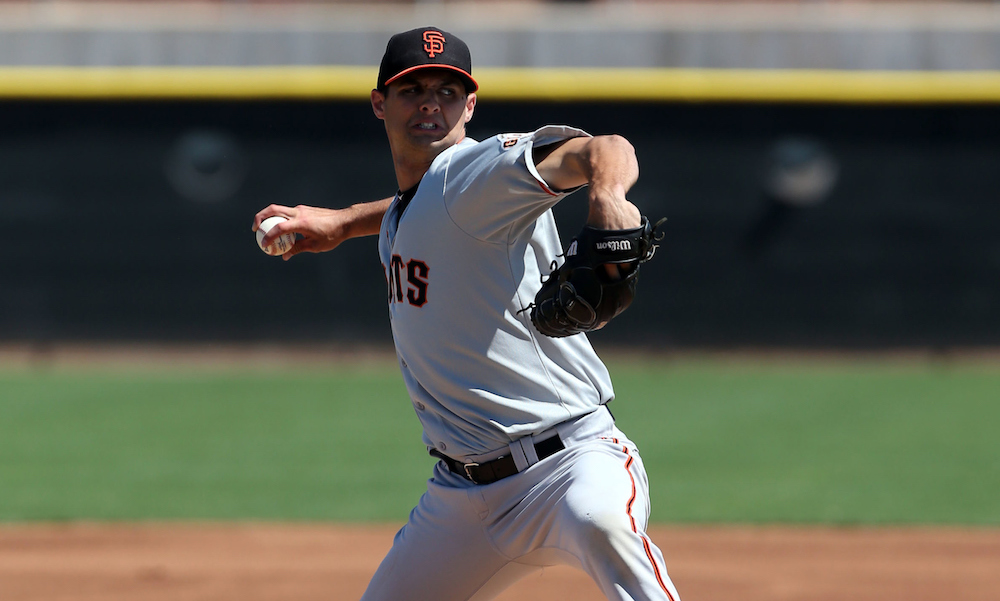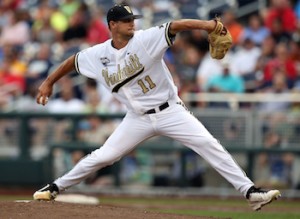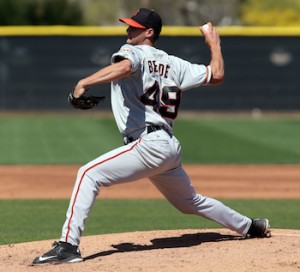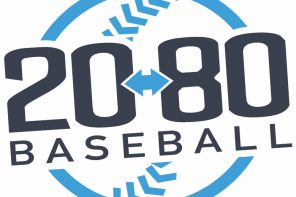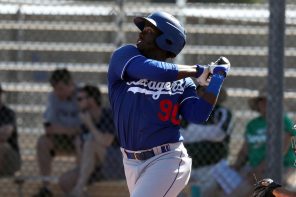Feature Photo: Tyler Beede, RHP, Giants
 In the case of Tyler Beede’s first full season with Double-A Richmond, he will be the first to tell you it was different than previous season. He had spent time with the Flying Squirrels last season, but this season simply held a different feel — a result of renewed confidence on the mound; confidence stemmed from understanding exactly what he’s capable of.
In the case of Tyler Beede’s first full season with Double-A Richmond, he will be the first to tell you it was different than previous season. He had spent time with the Flying Squirrels last season, but this season simply held a different feel — a result of renewed confidence on the mound; confidence stemmed from understanding exactly what he’s capable of.
A glimpse of that progress took center stage on an August evening in the second to last start for the 23-year-old right-hander. The Giants number two prospect – according to MLB Pipeline – registered a complete game shutout, the first of his professional career, tacking on 11 strikeouts; another career first. Beede had tossed shutouts before, but there was something that stood out about the authority he exhibited that evening.
One of just 20 players in history to be selected in the first round of the Major League draft twice, Beede knows a thing or two about having his development meticulously broken down on a daily basis. Despite the added attention, he has remained blissfully unaware of the media’s dissection, because at the end of the day, he’s his own biggest critic.
“It’s a good thing to be a critic of yourself, just because there’s always that feeling of never being satisfied for me,” Beede said. “When I have a good day at the field or even a bad day, it’s a moment for me to reflect and see where I need to get better.”
The younger of two sons to Walter Beede and Cheryl Rivers, baseball has always stood at the forefront for Tyler and his family, even with Tyler growing up as a three-sport athlete. Walter, a 1981 13th-round pick by the Chicago Cubs out of Fitchburg High School in Massachusetts played a year at the minor league level before transitioning to coaching, in order to make sure Tyler and his older brother Kyle were able to receive the instruction they needed.
“I think the love for the game just manifested from that and I just started realizing a talent that I had; a gift for the game,” Beede said. “My dad would always make sure that I was aware of how far my abilities could take me in this game and to always focus on hard work. I think I fell in love with the game once I started having a little bit of success and seeing how fun it was.”
Walter’s awareness of Tyler’s skillset and that little bit of success landed them at the door of Cressey Sports Performance to begin training with its president and co-founder, Eric Cressey. A certified strength and conditioning specialist with practices in Hudson, Massachusetts and Jupiter, Florida, Cressey has grown quickly to become one of the most sought after performance instructors in the United States, working with athletes anywhere from the high school level up to Olympic training.
The first interaction between the two is still one that makes Cressey smile to this day.
“We often joke about it,” he said with a laugh. “I think on that first day he was like “What am I doing here? Where is my dad taking me?” His dad had a lot of foresight to get him started with strength and conditioning at a young age.”
Following that introduction, it didn’t take long for Cressey to see he had something special on his hands. “I think Tyler was very, very good particularly at a young age,” Cressey recalled. “His changeup was incredibly advanced in high school. Certainly, the arm speed came along as he got stronger and built some athleticism and all that. But the pitching side of things, he knows how to pitch.”
As the development progressed, Cressey soon discovered a notable key in Beede’s performance, specifically in his ability to maintain the velocity of his fastball.
“Probably the biggest thing for Tyler that we’ve learned over the years, is that his success hinges really, really heavily on his body weight,” Cressey said. “If he doesn’t keep his weight up in season, if he doesn’t eat enough; literally, it has a very linear relationship with his velocity.”
The mid-90’s velocity during his senior year of high school got the attention of major league scouts and Beede was selected in the first round (21st overall) of the 2011 draft by the Toronto Blue Jays. This was quickly followed up with the difficult decision to choose between a jump to professional baseball and an opportunity to continue his development at Vanderbilt University under the tutelage of head coach Tim Corbin.
Since joining the Commodores coaching staff in 2003, Corbin’s player development reputation long preceded him and was instrumental in helping Beede to settle on his decision.
“There are tremendous college coaches throughout the country,” Beede said. “But, Corbin was a guy or is a guy who cares deeply about developing you as a person.”
Despite training in the seasoned shadow of Corbin, Beede’s introduction into the Southeastern Conference made it clear that this conference played no favorites.
“I had no shortage of adversity, I’d say, at Vanderbilt,” Beede said. “It was great for me, obviously in the moment, going through a freshmen year, going through some ups and downs as a guy who had success. It was an opportunity for me to really step back and reflect and really take the adversity as a blessing.”
With the Commodores, the Massachusetts native saw his greatest success as a sophomore, finishing 14-1 over 17 games, dropping his ERA by two points from his freshman season (down to 2.32), as well as lowering his WHIP from 1.52 to 1.26.
With Cressey keeping an eye out from a distance, the success of Beede didn’t come as a shock.
“He’s got these freakishly long fingers, where he can do some very special things for his changeup,” Cressey said. “I remember for a while at Vanderbilt people were saying “Oh, Ty’s throwing a cutter.” And I remember texting him, like “Did you start throwing a cutter?” He’s like “No, I can just cut my changeup when I want to.” He can do pretty crazy things with the ball that not everybody can do.”
It was that creativity that prodded the Giants to jump at the chance to snag Beede in the first round of the 2014 draft, this time with the 14th-overall pick. Ever his biggest critic, Beede didn’t feel as though he was where he should be to deserve another first-round slot, but the Giants saw something in the right-hander and felt otherwise.
Carrying his three-pitch arsenal into 2016, weight management and consistency stayed as the primary focal points for Beede once again. A fastball flashing 70-grade velocity, touching as high as 98 mph during his complete game outing in August has proven to be the selling point of the 23-year-old, tying in with a changeup and curveball that both project as 55-grade offerings.
“In terms of last year and this year, I think the weight is probably the most noticeable difference, but for me, personally, my command for my fastball, my development of my off-speed pitches and how frequently I’m throwing quality pitches in the zone is more-so than I’ve ever done in my whole career.”
In addition to Corbin’s leadership, Beede is quick to credit the Giants minor league staff for cultivating the natural ability that he had already brought to the table.
“I just think I’m a whole couple of years further than I figured I would be at this point,” Beede said. “It really is thanks to the pitching development guys in this organization, Dick Tidrow, Bert Bradley and even Steve Kline and Mike Couchee. They’ve done a great job of not only instilling confidence in me, but helping me get some cues in my mechanics that allow me to throw with more confidence and more consistency.”
It was that consistency that produced a three-point drop in his ERA this season from his partial season Double-A debut in 2015. Over 147.1 innings of work, Beede dropped his walks per nine innings from 4.3 to 3.2, raising his strikeouts per nine from 6.1 in 2015 to 8.2 in 2016. In addition, being able to work his fastball in both a two and four-seam form has proven to miss bats on a regular basis, especially as his command has continued to improve.
Since maintaining his body weight has taken a front seat for Beede, the velocity in that four-seamer has evolved the offering into one of Beede’s best pitches to-date.
“If a guy’s late on my fastball, I’ll probably throw the four-seamer and try to throw it by him, or try to get him leaning over the plate or something like that,” Beede said. “I’m definitely throwing the four-seamer probably three times more than I did last year, just because it has that velocity and it can really set up the sinker on the inside part of the plate or it can set up that curveball too.”
Since the completion of the 2016 season, Beede is back to work with Cressey, bypassing fall and winter league activity to focus on the consistency that Cressey believes will carry Beede to San Francisco in 2017.
The beauty in what Beede brings to the table for the Giants organization is what every pitching coach hopes for, and that’s natural ability. As he continues to work on consistency in command and keeping his walks down, I can see Beede working well as a number four starter with an easy shot at a call-up next season.
For Beede, the plan hasn’t changed. A diverse arsenal and that little bit of success from early on have handed the Giants what could ultimately develop into a key addition to their starting rotation.
“I think he’s a guy who could, very easily, pitch in the big leagues next year,” Cressey said. “I think this is a guy who could go out and give you 180-to-200 innings next year and be very durable in doing so.”

